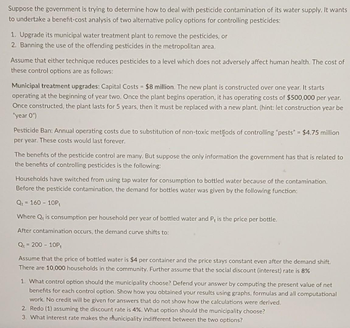
ENGR.ECONOMIC ANALYSIS
14th Edition
ISBN: 9780190931919
Author: NEWNAN
Publisher: Oxford University Press
expand_more
expand_more
format_list_bulleted
Question
Hi, this question has been posted before but it wasn't complete and solved the right way.
You should solve it and include graphs and all the calculations and explanation as well, as mentioned in the questions.
Please solve it with all your heart. I need to understand the steps one by one with graphs and tables.
If you don't know how to solve it completely. Please to do not answer it and leave it for someone else, who is good at economics and is able to solve the whole problem correctly and accurately.
Thank you and I appreciate it
I'll give a thumbs up for the best solution

Transcribed Image Text:Suppose the government is trying to determine how to deal with pesticide contamination of its water supply. It wants
to undertake a benefit-cost analysis of two alternative policy options for controlling pesticides:
1. Upgrade its municipal water treatment plant to remove the pesticides, or
2. Banning the use of the offending pesticides in the metropolitan area,
Assume that either technique reduces pesticides to a level which does not adversely affect human health. The cost of
these control options are as follows:
Municipal treatment upgrades: Capital Costs $8 million. The new plant is constructed over one year. It starts
operating at the beginning of year two. Once the plant begins operation, it has operating costs of $500,000 per year.
Once constructed, the plant lasts for 5 years, then it must be replaced with a new plant. (hint: let construction year be
"year 0")
Pesticide Ban: Annual operating costs due to substitution of non-toxic methods of controlling "pests" = $4.75 million
per year. These costs would last forever.
The benefits of the pesticide control are many. But suppose the only information the government has that is related to
the benefits of controlling pesticides is the following:
Households have switched from using tap water for consumption to bottled water because of the contamination.
Before the pesticide contamination, the demand for bottles water was given by the following function:
Qt=160-10P,
Where Q is consumption per household per year of bottled water and P, is the price per bottle.
After contamination occurs, the demand curve shifts to:
Q = 200-10Pt
Assume that the price of bottled water is $4 per container and the price stays constant even after the demand shift.
There are 10,000 households in the community. Further assume that the social discount (interest) rate is 8%
1. What control option should the municipality choose? Defend your answer by computing the present value of net
benefits for each control option. Show how you obtained your results using graphs, formulas and all computational
work. No credit will be given for swers that do not show how the calculations were derived.
2. Redo (1) assuming the discount rate is 4%. What option should the municipality choose?
3. What interest rate makes the municipality indifferent between the two options?
Expert Solution
This question has been solved!
Explore an expertly crafted, step-by-step solution for a thorough understanding of key concepts.
This is a popular solution
Trending nowThis is a popular solution!
Step by stepSolved in 4 steps

Knowledge Booster
Learn more about
Need a deep-dive on the concept behind this application? Look no further. Learn more about this topic, economics and related others by exploring similar questions and additional content below.Similar questions
- I need help for these questions l.arrow_forwardMark is currently earning $44,000 a year. He has worked for this firm for 5 years. He is considering a job that will increase his lifetime earnings by $240,000 but that requires a Ph.D. in finance. The job will mean also attending a full-time finance program for four years at an annual cost of $28,500. Mark already completed an MBA, for which he spent $86,000 in tuition and books. Would he take the job and attend the Ph.D. program? Calculate: Insutructions: Use ono decimals. Use commas (30,000, not 30000). Opportunity costs of this decision = $ MC = $ MB = $ Sunk Costs = $arrow_forwardAlexandra's Production Possibilities Natalia's Production Possibilities Schedule Schedule Number of Scarves Number of Sweaters Number of Scarves Number of Sweaters Knitted per Day Knitted per Day Knitted per Hour Knitted per Hour 4 3. 2 6. 2 4 2 9. 1 6. 12 8. Which of the following is an acceptable term of trade? Multiple Choice 6 sweaters for 10 scarves 4 sweaters for 10 scarves 2 sweaters for 7 scarves 8 sweaters for 15 scarvesarrow_forward
arrow_back_ios
SEE MORE QUESTIONS
arrow_forward_ios
Recommended textbooks for you

 Principles of Economics (12th Edition)EconomicsISBN:9780134078779Author:Karl E. Case, Ray C. Fair, Sharon E. OsterPublisher:PEARSON
Principles of Economics (12th Edition)EconomicsISBN:9780134078779Author:Karl E. Case, Ray C. Fair, Sharon E. OsterPublisher:PEARSON Engineering Economy (17th Edition)EconomicsISBN:9780134870069Author:William G. Sullivan, Elin M. Wicks, C. Patrick KoellingPublisher:PEARSON
Engineering Economy (17th Edition)EconomicsISBN:9780134870069Author:William G. Sullivan, Elin M. Wicks, C. Patrick KoellingPublisher:PEARSON Principles of Economics (MindTap Course List)EconomicsISBN:9781305585126Author:N. Gregory MankiwPublisher:Cengage Learning
Principles of Economics (MindTap Course List)EconomicsISBN:9781305585126Author:N. Gregory MankiwPublisher:Cengage Learning Managerial Economics: A Problem Solving ApproachEconomicsISBN:9781337106665Author:Luke M. Froeb, Brian T. McCann, Michael R. Ward, Mike ShorPublisher:Cengage Learning
Managerial Economics: A Problem Solving ApproachEconomicsISBN:9781337106665Author:Luke M. Froeb, Brian T. McCann, Michael R. Ward, Mike ShorPublisher:Cengage Learning Managerial Economics & Business Strategy (Mcgraw-...EconomicsISBN:9781259290619Author:Michael Baye, Jeff PrincePublisher:McGraw-Hill Education
Managerial Economics & Business Strategy (Mcgraw-...EconomicsISBN:9781259290619Author:Michael Baye, Jeff PrincePublisher:McGraw-Hill Education


Principles of Economics (12th Edition)
Economics
ISBN:9780134078779
Author:Karl E. Case, Ray C. Fair, Sharon E. Oster
Publisher:PEARSON

Engineering Economy (17th Edition)
Economics
ISBN:9780134870069
Author:William G. Sullivan, Elin M. Wicks, C. Patrick Koelling
Publisher:PEARSON

Principles of Economics (MindTap Course List)
Economics
ISBN:9781305585126
Author:N. Gregory Mankiw
Publisher:Cengage Learning

Managerial Economics: A Problem Solving Approach
Economics
ISBN:9781337106665
Author:Luke M. Froeb, Brian T. McCann, Michael R. Ward, Mike Shor
Publisher:Cengage Learning

Managerial Economics & Business Strategy (Mcgraw-...
Economics
ISBN:9781259290619
Author:Michael Baye, Jeff Prince
Publisher:McGraw-Hill Education